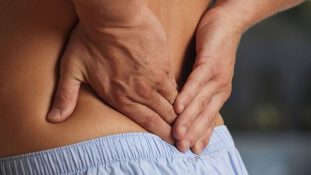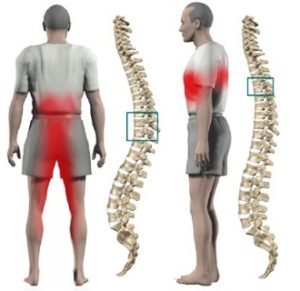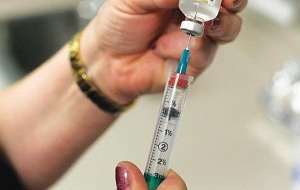Lumbar spine osteochondrosis, with a variety of symptoms and treatments, is one of the most common pathologies of the musculoskeletal system.
This condition is characterized by the development of degenerative-dystrophic changes in the intervertebral discs that spread over time to the ligaments and bone tissue of the vertebrae of the lumbosacral spine. In the absence of therapy, the acute process inevitably becomes chronic.
Degenerative disease can make a healthy person disabled.
Extent of lumbar spine osteochondrosis
Classifies 4-degree osteochondrosis of the lumbosacral region. The pattern of the disease is as follows:
First degree.Lesions form in the form of cracks inside the annulus fibrosus, where the contents of the nucleus pulposus penetrate, causing irritation. This is the initial stage of osteochondrosis. The deformation of the intervertebral discs is barely expressed and causes reflex pain with sudden movements and heavy lifting. Unpleasant sensations in the lower spine can be mild and can manifest:

- lumbodynia - local, persistent pain in the lumbar spine;
- lumbago - suddenly painful "lumbago" in the lower back.
Second degree.Destructive processes continue in the fibrous ring. The distance from one vertebra to the other decreases, causing the nerve fibers to compress. There is discomfort in the lower third of the back, which sometimes turns into pain attacks.
Third degree.During this period, the final destruction of the annulus fibrosus occurs by extrusion of the nucleus pulposus. The vessels and nerve endings are compressed by intervertebral discs. An intervertebral hernia is formed. The spine is curved, forming:
- lordosis - curved deformity in the lumbar spine, with the bulge of the spine advancing;
- kyphosis - a situation opposite to lordosis when the arc turns outwards;
- scoliosis - pathological bending of the spine to the right or left.
The last stage of osteochondrosisis considered the most severe and dangerous. By this time, the spine is already deformed, normal motor activity is lost. X-rays show a bone growth in the lumbar spine - a reaction of the body. The pain may be absent for a while, but it does not mean improvement. People with stage 4 osteochondrosis of the sacro-lumbar spine often become disabled. This is because the process is complicated at this stage.
Causes of lumbar spine osteochondrosis
Causes of lumbar osteochondrosis include:
- Disproportionate load on the spine.Man is an upright being, so a load on the spine is considered normal when standing. You have to move, bend and bend as you perform various actions. In order to maintain the desired state of the body, the musculoskeletal system is in a state of prolonged tension. In a sitting position, the load on the spine will increase and lying on your back will be minimal. When a person is in a position for a long time, the lumbar and sacral spine are overloaded and the muscles do not relax, causing first discomfort and then pain. This deforming factor underpins the preconditions for the development of lumbar spine osteochondrosis.
- Sedentary lifestyle.It contributes to the development of various pathologies, including those that affect the structure of the vertebrae. Prolonged sitting causes deformity of the cartilage tissue and a decrease in muscle tone, which provokes the development of lumbar osteochondrosis.
- Excessive physical exertion.Lack of intense physical activity and excessive levels also do no good for the musculoskeletal system. Long, hard work, especially lifting and carrying weights, leads to overload of the back muscles and the formation of a vertebral hernia.
- Postural disorders.Deformation of intervertebral discs can also be caused by improper gait. This is again due to the uneven load on the spine. Intervertebral discs lose their flexibility and mobility, so they are more likely to be damaged. Older and older people face similar problems.
- Bone defects, hereditary pathologies, trauma and infectious lesions.Osteochondrosis is often the result of birth defects in the musculoskeletal system. For example, if the cartilage tissues in the body are naturally fragile. In addition, spinal pathology develops after traumatic injuries and infectious processes, as in osteomyelitis and tuberculosis.
- Flat legs.Signs of a "special" foot are the lack of notches and sagging of the arches. Those who have this trait often face spine problems. This is due to the increased load on the intervertebral discs while walking. They are exposed to increased physical stress during movement throughout their lives, so they wear out quickly
- Obesity.Being overweight is a problem and an additional burden on the body. All organs and systems suffer, including the spine.
- Abnormal processes.Malfunctions of various structures can adversely affect the condition of the musculoskeletal system. Thus, the factors that trigger osteochondrosis of the lumbar spine are endocrine disorders, cardiovascular problems, and gastrointestinal dysfunction.
- Improper lifestyle.Many people do not pay enough attention to simple and important things like physical activity, a balanced diet and normal sleep. Under stressful conditions, a body that has existed for a long time becomes weak and vulnerable. Other pathologies occurring in such "fertile" soils include lumbar osteochondrosis.
Symptoms of osteochondrosis of the lumbar spine

Pathological changes in the lumbar spine present with severe symptoms;
- low back painis the clearest "sign" of lumbar osteochondrosis. He speaks of the presence of "radical syndrome" when the compression of the nerve endings in the spine causes pain in the lumbar spine. The person will be tired and irritable. Over time, performing simple and routine activities becomes a major problem due to lumbar spine pain. If an intervertebral hernia has developed in the lumbar region, the pain radiates to the lower leg, the back of the thigh, and the foot. Over time, it becomes increasingly difficult to sit and walk. The unpleasant feelings do not let go even when lying down. Temporary relief may alternate with periods of exacerbation.
- is a dysfunction of the urogenital system.Pain in the kidney area, a frequent urge to urinate. Deformation of the intervertebral discs causes dislocation of the lumbar spine relative to the sacrum. This affects the work of the internal reproductive organs of women, causing problems of potency in men;
- decreased sensitivity of the feet in the foot area.This can be partial or absolute. However, the reflexes in this part of the body are weakened. Progressive pathology leads to complete loss of sensitivity in the lower extremities;
- gait disturbances.The pain associated with osteochondrosis of the lumbar spine causes a person to deviate from the opposite direction of tightening nerve fibers while walking. The condition does not allow long distances. A lame person is forced to stop pain relief from time to time. Timely medical help can save a person from a disability.
Treatment of lumbar spine osteochondrosis
Many people wonder if and how osteochondrosis of the lumbar spine is treated. Therapeutic tactics are determined at the time of diagnosis and diagnosis.
There are several methods for treating lumbar osteochondrosis. Which is necessary and advisable to use to cure a disease or alleviate a person's condition as much as possible, the doctor determines.
Someone treats themselves exclusively with folk remedies, at home, forgetting that they can only be used with the approval of a medical specialist and only as part of a complex therapy.
Medication for osteochondrosis
Drug therapy involves the use of:
- tablet forms;
- solutions for injection;
- preparations for external use - ointments and gels.
Medications are prescribed to eliminate inflammation and relieve pain in the lumbar spine. They can be used at home.

These can be:
- analgesics;
- non-steroidal anti-inflammatory drugs;
- medicines for muscle cramps (muscle relaxants);
- device for cartilage tissue repair (chondroprotectors);
- Corticosteroids (hormone-containing medicines that relieve pain and inflammation)
- vitamins.
The course of treatment is prescribed by a doctor, who occasionally prescribes tablets or decoctions to calm the nervous system as an adjunct treatment.
Physiotherapy for lumbar osteochondrosis
Physiotherapy is another common method of relieving the symptoms of lumbar osteochondrosis. By acting on the spine and lower back, it enhances metabolic and restorative processes.
Most commonly written:
- magnetic, laser and electrotherapy;
- phonophoresis;
- shock wave method;
- detensor therapy;
- vibrating massage;
- balneotherapy.
How many and what procedures will be needed - the doctor will decide.
Physiotherapy is effective in the early stages of pathology. But he, like other types of treatments, has contraindications. Therefore, the physician considers a number of factors when prescribing the method.
Lumbar osteochondrosis therapy gymnastics
The goal of physical exercises in lumbar osteochondrosis is to restore the mobility of this spine.
Regularity is considered a key condition for its effectiveness. Occasional exercises do not produce the desired effect.
If the body already has complications from osteochondrosis, this method is not used. In addition, its use is contraindicated in severe pathologies of other organs and systems, as well as the presence of pain in the pelvic region and above.
Surgical intervention for lumbar spine osteochondrosis
The surgical method is used in the presence of serious complications such as intervertebral hernia. Partial or complete discectomy of the damaged intervertebral disc is performed as required by the operating protocol.
The indications for surgery are as follows:
- is a severe and persistent pain syndrome that cannot be removed with medication for a month;
- is the large size of the hernia and its effect on the spinal cord.
Osteochondrosis is easier to prevent than to cure. As with any pathology, it is potentially dangerous for severe complications. It is important to understand that more or less complete elimination of this pathology is possible at the earliest stages, when the deforming effect on intervertebral discs is minimal. In other cases, we can only talk about relieving the symptoms and maintaining the condition of the body, which allows for a normal life and work.













































